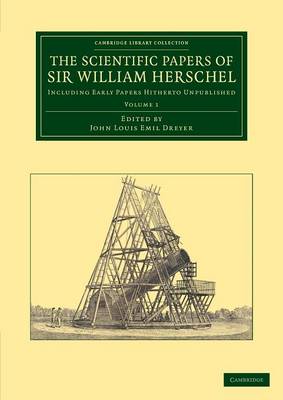Cambridge Library Collection - Astronomy
3 total works
The Scientific Papers of Sir William Herschel 2 Volume Set
by William Herschel
Published 5 September 2013
By the time of his death, William Herschel (1738-1822) had built revolutionary telescopes, identified hundreds of binary stars, and published astronomical papers in over forty volumes of the Royal Society's Philosophical Transactions. This two-volume collection, which originally appeared in 1912, was the first to gather together his scattered publications. It draws also on a wealth of previously unpublished material, from personal letters to numerous papers presented to the Philosophical Society of Bath. Although Herschel is best known for his discovery of Uranus, this collection highlights the true range of his observations and interests. Focusing on his early work, Volume 1 includes notes on the discovery of Uranus and a biographical account by the historian of astronomy J. L. E. Dreyer. Volume 2 features later work, including studies of solar heat and the atmosphere of Saturn. It also features an appendix of work compiled by his son, John Herschel, and sister Caroline.
The Scientific Papers of Sir William Herschel: Volume 2
by William Herschel
Published 5 September 2013
By the time of his death, William Herschel (1738–1822) had built revolutionary telescopes, identified hundreds of binary stars, and published astronomical papers in over forty volumes of the Royal Society's Philosophical Transactions. This two-volume collection, which originally appeared in 1912, was the first to gather together his scattered publications. It draws also on a wealth of previously unpublished material, from personal letters to numerous papers presented to the Philosophical Society of Bath. Although Herschel is best known for his discovery of Uranus, this collection highlights the true range of his observations and interests. Focusing on his later work, Volume 2 includes notes on some of the moons of Uranus, studies of solar heat and the atmosphere of Saturn, and some practical experiments investigating the capabilities of contemporary telescopes. It also features an appendix of work compiled by his son, John Herschel, and sister Caroline.
The Scientific Papers of Sir William Herschel: Volume 1
by William Herschel
Published 5 September 2013
By the time of his death, William Herschel (1738–1822) had built revolutionary telescopes, identified hundreds of binary stars, and published astronomical papers in over forty volumes of the Royal Society's Philosophical Transactions. This two-volume collection, which originally appeared in 1912, was the first to gather together his scattered publications. It draws also on a wealth of previously unpublished material, from personal letters to numerous papers presented to the Philosophical Society of Bath. Although Herschel is best known for his discovery of Uranus, this collection highlights the true range of his observations and interests. Focusing on his early work, Volume 1 includes notes on the discovery of Uranus, unpublished papers on electricity, and studies of the lunar mountains and the poles of Mars - both of which he believed to be inhabited. It also features a biographical account by the historian of astronomy J. L. E. Dreyer.


